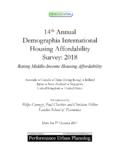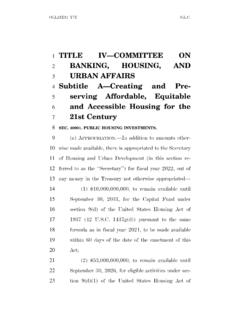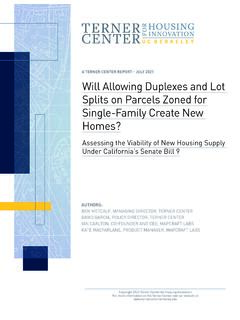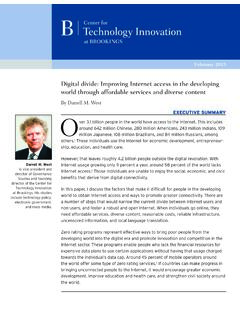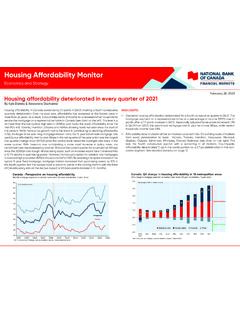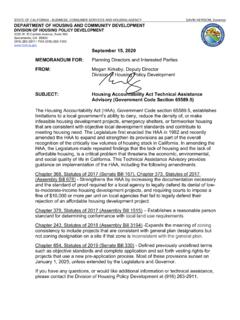Transcription of Mixed Use and Mixed Income Housing Development
1 Multi-Family, Mixed Use and Mixed Income Housing DevelopmentWhat is a Mixed -Use Project? Mixed -use Development is an example of flexible zoning which allows various types of land uses, including office, commercial, residential, and in some cases, light industrial or manufacturing, to be combined within a single Development or district. A major purpose of Mixed -use zoning is to allow a balanced mix of office, commercial, and residential uses in close proximity to increase convenience to residents and reduce the number of shopping and/or commuting trips needed.
2 Mixed -use developments can range in size from single buildings with apartments located over retail uses, to large-scale projects that include office and commercial space along with hotels, convention centers, theaters, and Residential and Retail DevelopmentMadison Crossing, in Seattle WA, features 24 residential units, a 15,000-square-foot ground-floor grocery and a parking garage on the second of Mixed Use Projects Mixed -use projects can offer cost savings to developers in the form of shared parking arrangements and shared costs for building operation, maintenance, and security.
3 Commercial uses can help subsidize affordable or low- Income Housing , which may be necessary because of high urban land prices and Development costs. Mixed -use projects can create new Housing opportunities in areas that may have previously allowed only commercial, office, or light industrial of Mixed Use Projects Mixed -use projects offers one way to accommodate the higher Housing densities. Higher density Housing in commercial zones may be more politically acceptable than increasing densities in established single-family zones.
4 Mixed -use projects can be utilized to better integrate land uses by locating residential developments near downtown commercial (shopping) areas. With residents working or shopping close to home, traffic congestion is reduced. Allowing Mixed uses can help to revitalize distressed neighborhoods by creating a sense of community and Challenges of Mixed -Use Projects Higher costs Large financing gaps Unproven market demand Difficulty in implementationHigher Costs in Mixed Use ProjectsMixed-use projects often have higher costs per square foot than other projects because of costs associated with parking structures, firewalls between ground-floor commercial and upper-floor residential units, elevators.
5 And advanced fire suppression Financing Gaps in Mixed Use Projects Mixed -use projects, particularly those that incorporate some element of affordable Housing , often face both cost gaps and affordability gaps associated with both the Housing and the commercial uses. Cost gaps = the difference between the cost of Development and what the market is willing to finance. affordability gaps = the difference between market rates and what the project s target market can afford to pay. The majority of Mixed -use projects, both nationally and locally, require significant public subsidies.
6 The challenge of filling these gaps is compounded by the fact that there are relatively few subsidy sources for commercial real estate Development and that many common Housing subsidy tools are not well suited for projects that consist of multiple Market Demand in Mixed Use Project There are relatively few Mixed -use projects in the most communities. Most Housing in the most communities is located in distinctly residential areas. Therefore, many funders and lenders remain unconvinced of the demand for Housing on busy commercial streets and transit in Implementation in Mixed Use Projects Projects with multiple uses are inherently more complex and less efficient to design, finance and manage.
7 Because Housing and commercial uses are fundamentally different, they require different design features, different financing tools (with different underwriting standards) and different management skills. In some cases, the demands of Housing and commercial uses conflict in ways that make it difficult to market the product. Bringing all of the divergent components together so that they complement each other is the key to having a successful Mixed -use of Successful Mixed -Use Projects Specific goals for both the Housing and commercial components of the project, informed by careful market analysis that verifies the needs and assumptions underlying those goals.
8 Development teams with solid experience in Mixed -use design, commercial leasing, Housing & commercial financing, and property management. Sites located within existing commercial districts with good visibility & access to transit and roads. Architectural designs that accommodate specific needs for commercial uses into the project on the front end, while incorporating unique elements that attractively integrate the projects into their communities. Careful selection of a strong and unique mix of commercial tenants. Sufficient parking that will adequately serve the needs of commercial and Housing tenants.
9 Partnerships with municipalities on site assembly and the financing of infrastructure improvements. The use of phasing for large, multi-block projects when resources are not sufficient to undertake all activities at one time. Creative financing opportunities for short, medium and long term investors that allow the commercial portion of the project to establish its customer base. Realistic pro formasthat include funds for tenant improvements, rents that are in line with the market, a healthy vacancy rate for the commercial, and tested assumptions for operating expenses.
10 Legal structures that separate the different uses when necessary to obtain financing. Incorporation of civic uses, public or green spaces such as libraries, banks, community centers, urban parks, and creative Uses and Risk in a Mixed Use Development The least risky non-residential use to develop is community program space, which even though do not produce rent or revitalize commercial corridors, they can provide tremendous benefits to a supportive or affordable Housing project. Developing space for a childcare centeror as office space for the sponsoring agency or another non-profit group can be a reliable way to generate Income from the commercial space, without takingon too much financial risk.
